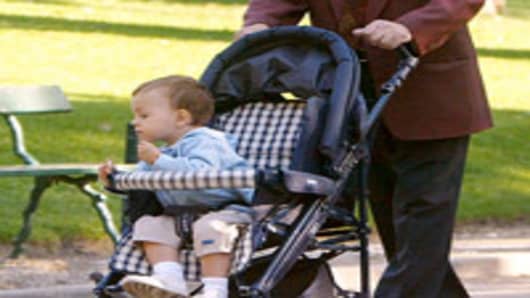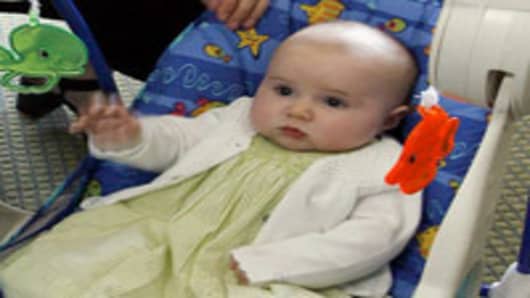The pitter-patter of little feet and the high-pitched cries of infants may seem louder lately, but it's music to the ears of many companies that cater to infants and children.
Last year, more than 4.3 million babies were born in the US - the largest number in a single year - according to the National Center for Health Statistics.
Although the 3 percent increase over 2006 falls short of a double-digit percentage to be considered a true baby boom by demographers, the rising birth rate is significant enough to provide a growing customer base for manufacturers and merchants.
“Companies that have a vested interest in all things babies will benefit,” says Ken Harris, of consulting firm Cannondale Associates.
“Consumers, generally, tend to not skimp on their children," Harris says, adding that this trend is true even in tough economic times. "Parents will trade down in other areas.”
Analyst Paul Hickey of Bespoke Investment Group is tracking companies that he expects to profit from the influx of newborns, particularly those that focus on clothing, education, and healthcare for children.
Stocks he likes includes neonatal and infant diagnostic equipment company Natus Medical , which is growing through several small acquisitions, as well as Martek Bioscience , the patent-owners of an active ingredient in baby formula. Martek also is expanding into baby food products and pregnancy supplements.
LeapFrog , the educational toy company, also is another favorite among children-related stocks. They will be launching a new line of products for the holiday season, including a pen tool that helps children read.
“Basically with all three of these names what we want to look for is, not only companies that can benefit from the growth in births, but also companies that have growth traits because of new product launches,” says Hickey. (For more on Hickey's picks, watch the accompanying video.)
The baby boom may also create new rivalries. In a bid to broaden their franchise, Kimberly-Clark , the maker of Huggies diapers, and Procter & Gamble , the maker of Pampers diapers, introduced skincare and toiletries for infants and toddlers a few years ago. These products have been gaining strength in a segment of the baby care category dominated by Johnson & Johnson .
Morgan Stanley analyst Bill Pecoriello said he would not be surprised if Kimberly-Clark and P&G look to develop these product segments further.
Acquiring Small, Niche Companies
One way they can do this is through acquisitions of small, niche companies, Pecoriello said. However, he did not name any specific aquisition targets.
P&G and Kimberly-Clark declined to comment on any specific plans for future deals. However, a Kimberly-Clark spokesman said, “We are always looking for strategic ways to strengthen our positions in baby and childcare.”
Spending on baby items also may get a boost from the purchasing power of the "boomer grandparent," who enjoy indulging their grandchildren's needs and have more to spend than past generations of grandparents, said Fisher-Price spokeswoman Crystal Voisin.
According to the company's product research, this trend is helping to fuel sales of Fisher-Price's "BabyGear" product line, which includes their top-selling swings and bouncers, as well as high chairs and infant seats, Voisin said.
Fisher-Price would not disclose sales for specific items.
Fisher-Price, a unit of Mattel , also has been careful to target Latina moms, who account for about one in five births, with Spanish-language "magalogs" both before and after their children are born. This type of advertising, which is a cross between a magazine and a catalog, offers parenting tips alongside product information, Voisin said.
Fisher-Price also is lobbying large retailers such as Wal-Mart Stores and Target to expand shelf space in the baby and infant categories.
The timing of the increased births couldn't be better for retailer Gymboree , which best known for its apparel for toddlers and young children. The San Francisco company recently relaunched its "Brand New" line in an attempt to target babies right out of the hospital.
“A baby boom is good news for us, it times nicely with the line,” said Gymboree spokesman Jamie Falkowski.
However, unlike in past baby booms, this generation of parents will find themselves faced with a plethora of choices.
According to Harris, there is a “new bi-polar phenomenon of high-end and low-end products,” which offers parents the choice of indulging or being budget conscious.
For example, Newell-Rubbermaid’s Graco cribs and strollers are priced around $100 to $250 compared with the pricey Bugaboo Cameleon stroller that costs about $900 or the Los Angeles-based furnishing firm Nursery Works' cribs that can fetch about $2,000.
Gymboree's clothing brands run the gamut from their more budget-conscious clothing line Crazy Eights to its higher-priced Janie and Jack.
Fisher-Price's BabyGear also markets to different budgets. Its Rainforest line features jungle themes and lower priced items than their luxury Zen collection.



